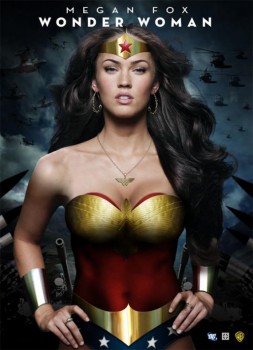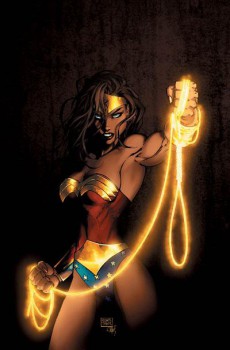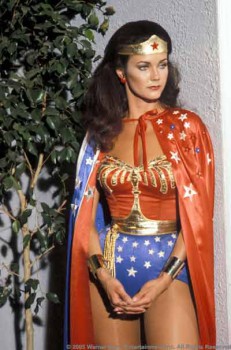Art of the Genre: Art of the Iconic Female #3: Wonder Woman
 I have no memory of the first time I saw Wonder Woman, although I’d assume it wasn’t the comic but the live action 70s TV version with Linda Carter. Recollections of those shows were certainly something that stuck with me as they sparked something in my prepubescent state that would certainly lead to a grander appreciation of the female form as I grew up. Remember, this was circa 1975-1979, so I was only a max of 8 years old when watching them and yet the name Linda Carter still quickens my heart rate to this day. Something about that just isn’t right… or I guess in the case of DC Comics bottom line is exactly right.
I have no memory of the first time I saw Wonder Woman, although I’d assume it wasn’t the comic but the live action 70s TV version with Linda Carter. Recollections of those shows were certainly something that stuck with me as they sparked something in my prepubescent state that would certainly lead to a grander appreciation of the female form as I grew up. Remember, this was circa 1975-1979, so I was only a max of 8 years old when watching them and yet the name Linda Carter still quickens my heart rate to this day. Something about that just isn’t right… or I guess in the case of DC Comics bottom line is exactly right.
Perhaps that reaction today isn’t such a good thing, as my wife is wont to remind me, but the ability of the American propaganda and marketing machine was certainly gearing up to a fevered pitch in that glamorous disco-tropic decade concerning how women should look and what they should wear.
Wonder Woman, for all her powerful beginnings, finds herself cast in the role of sex object just as 95% of all other super heroines, and that is a tragedy.
Silly side note here, my mother has always watched The Young and the Restless, and therefore I’ve always watched The Young and the Restless. It humors me greatly that the twenty odd characters in the show must always get together, break up, and then get together with someone else again and again and again. After several decades, relationship trees become so convoluted that I get great joy at having a running dialogue as I watch the show detailing just how inherently creepy each new relationship has become when I get to count how many people in each scene have slept together. In essence, comic books are the same beast, and with only a very limited number of super heroines to go around, I’ve always been intrigued by covers depicting them in the arms of an iconic super hero, my favorite being those with Wonder Woman and Superman thusly portrayed. I mean seriously, if you put in the words ‘Wonder Woman Kissing’ into Google, the first four default options are Nightwing, Superman, Batman, and Jean Grey [wowza!].
 Now I’m not going to get into a full on attack on super vixens, or villainesses, and what they wear [or don’t] and who they hook up with; that is too easy a bone to chew, but I would like to take a look at Diana of Themyscira as a character.
Now I’m not going to get into a full on attack on super vixens, or villainesses, and what they wear [or don’t] and who they hook up with; that is too easy a bone to chew, but I would like to take a look at Diana of Themyscira as a character.
First created in 1941 and depicted as assisting Allied forces against the Axis powers during World War II, Diana quickly captured hearts with her star-spangled skirt and impressive red and gold corset. William Moulton Marston, her creator, gave her the rather lofty back-story of being an Amazonian princess, come to the world of man to somehow assist it in such a troubled time.
Now first and foremost, let’s take a deeper look at the legend of Amazonia. Typically thought of as a Greek myth, the legends of Amazons are not only old but prevalent all through Asia Minor from before the time of Troy all the way up to Rome and even Late Antiquity. This society of women warriors were a tough group thought to have lived anywhere from Lybia to the Ukraine, participated in dozens of myths, and even had children sired by Alexander the Great.
They have been said to remove their left breast by either cutting or burning it off to better handle a bow or throw a spear. To continue their society, they would travel once a year to a settlement where they would mate with men and then return to their lands to have children, the boys either returned to their fathers, killed, or left in the wilderness to succumb to the elements. I found this last story particularly interesting because of the shared cycle principle, being that on female dorms the young women would begin to align in menstrual cycles if they remained together long enough. How impressive would it be if an Amazonian tribal elder tracked these cycles and thus could ensure the best day that all women in the city could conceive?
 Anyway, back to task, that being that Amazons were tough, and showed as much in their social economy as well as the many battles in which they were attributed to have taken part.
Anyway, back to task, that being that Amazons were tough, and showed as much in their social economy as well as the many battles in which they were attributed to have taken part.
In Marston’s choosing of his character’s origins, he tapped into something inherently grounded in the male subconscious, that being a fear of the inability to control women. Even Diana’s choice of weapon, a truth telling lasso, is pure genius as a psychological weapon against those of the Y chromosome. I mean, it can first bind you, taking your power, and then force you to tell nothing but the truth, a purpose that is both destructive and damning to both genders [because no woman would ever truly want to know what is going on in a man’s mind, trust me!].
Wonder Woman, therefore, is the great foil to the male dominated West, and yet we love her all the more for it. It is at her very core to hate any male-dominated society, and yet she chooses to forgo her own culture and help ours. That self-sacrifice humanizes her, and probably most importantly, gives common men a ‘shot’ at perhaps winning her heart.
The cheapening of her through this fashion is an unfortunate window dressing to a very intriguing and powerful character. Certainly, sex sells, and if your audience is teenage males, then showing off more skin than any woman warrior should care to is a must.
I forgive Diana this fact simply for the failures of my own society. As a man, I must say, the romance of a Frederick’s of Hollywood style super-suit [I didn’t use Victoria’s Secret here because that brand unbelievably has too much class for Wonder Woman’s outfit to be a part of] does make me take notice.
This outfit, which first appeared as a ruffled skirt, later evolved into a bathing suit, and finally has now transformed into a pair of pants, nonetheless has never lost its ability to show off Diana’s breasts like a dress from a bad Steampunk convention.
Does such a thing irrevocably detract from Diana’s prime mission statement of being a “distinctly feminist role model whose mission was to bring the Amazon ideals of love, peace, and sexual equality to a world torn by the hatred of men”?
It’s tough to say, because being both sexy and respected is nearly too sharp a razor’s edge to walk, especially if you cheapen yourself with streetwalker clothing. So is Wonder Woman an Iconic Female because she ranked 20th in Empire Magazine’s “Greatest Comic Book Characters” or because she got 5th in Comic Buyer’s Guide’s “100 Sexiest Women in Comics”? I’ll let you be the judge, but whatever the case, you’d be hard pressed to find someone in the U.S. who hasn’t heard of her, and for that she’s making this collection.
If you like what you read in Art of the Genre, you can listen to me talk about publishing and my current venture with great artists of the fantasy field or even come say hello on Facebook here. And my current Kickstarter novel’s promo can be found here
The sexual aspects of Wonder Woman have been there from the beginning. Her image was “purified” after the Comics Code Authority was imposed, and the sexuality was gradually reintroduced as the Code was loosened. Some of the early Wonder Woman stories that Marston wrote had some interesting, and by interesting I mean slightly kinky, overtones. I remember one in which a young woman was tied up. When she complained about it, Wonder Woman basically said she shouldn’t let it bother her and implied she should enjoy it. I’ve seen speculation that some of the content was consistent with Marsten’s personal life, which was a bit out of the mainstream. There’s a dissertation of two in there somewhere.
Westkeith: Nice introspection! I love it when readers add content with other interesting stories on the subject. I think a dissertation would be and entertaining read if what you say about Marsten is true.
It’s been a number of years, so I may be misremembering some details, but IIRC Marsden was a psychology prof who had an affair with one of his female graduate students. When he told his wife about it, she not only was OK with it, but went along with the idea that the three of them set up house together. (I have no clue whose idea it was.) He ended up having several children by each woman. I don’t recall where I read this other than it was one of the early history of comics. I’ll see if I can find the reference.
I completely agree with your point about writing for comic books and writing for soap operas being similar. One of the reasons DC has to reboot itself so often is their inability to handle the various reltionships which develop over time.
I have to disagree with you about Wonder Woman’s appearance though. I think it misses the essential feminist message of her character. She’s an Amazon, who lives in Man’s World (her words). She likes men, but she does not need them.
The character as portrayed in the comics is a positive role model for women. To throw that away because she’s wearing something no more risque than what a circus performer might wear (which can be said for most superhero costumes) I think is unfair. She was the first person on the cover of MS Magazine. They didn’t think the outfit was sexist, so what’s changed?
Don’t get me wrong, your point about women in comics is dead on, but you picked, in my opinion, a bad example. Artists like Cliff Chiang (Wondeer Woman) and Mahmud Asrar (Supergirl) have done a great job in providing positive, less sexual, heroines while still creating dynamic feminine heroes in their comics.
I think a better example of over sexualization would be what Guillem March did with the upcoming Catwoman #0 cover. Or have seen what they’ve got Harley Quinn wearing these day!
as an aside, all the bondage powers WW had in the beginning where retconned about the same time you were watching Linda Carter on TV. You know, back when she was a ninja for a few years.
Darangrissom: You could well be right on the outfit, although I think it can be taken to extremes it doesn’t need to be [see Adam Hughes]. I will continue to think of Wonder Woman fondly, and am very happy to promote her in some way in this list. 🙂
Wonder Woman was my first superhero. I was only dimly aware of Superman and the other big guys in comics, because I was only dimly aware of comics until college (and Watchmen and wow). But Wonder Woman was on television, where I spent a lot of time at age seven, and I’d never seen anything like her.
Some versions of her costume have been problematic, yeah, but when I was a seven year old girl spinning around and around in my room, pretending my army uniform was transforming into a gold bustier etc., I wasn’t imagining that I was becoming sexy. I was imagining that I was becoming powerful, important, a force for good in the world. And if Wonder Woman makes it possible for the people who grew up on her image to look at a woman in revealing garments and imagine, even subliminally, that she’s a powerful force for good in the world, then yay for Wonder Woman.
I think a dissertation would be and entertaining read if what you say about Marsten is true.
The weird superpower of the dissertation as a genre is to make absolutely any topic dull. I accidentally wrote a dissertation chapter about ritual sex (I started my research with a question about why T.S. Eliot and Ezra Pound et al. were so obsessed with the brand-new academic field of anthropology. Turns out the answer was ritual sex. Oops.) The chapter was only recognizable to my dissertation committee as academic writing at the point when I’d rendered it boring to everyone, including myself. There’s something really sad about eighty-seven pages on ritual sex with not one lively paragraph left.
That said, you can probably find some scholarly stuff about Wonder Woman at ComicsResearch.org
Sarah: It will be impossible for me to live the rest of my life without having flashes of your 7 year-old self spinning around you bedroom! 🙂
[…] Art-of-the-genre-art-of-the-iconic-female-3-Wonder-Woman […]
[…] If you’ve enjoyed this volume of my Iconic Female series, you can view #1 here, #2 here and #3 here. […]
[…] Scott Taylor also wrote about Wonder Woman here. […]